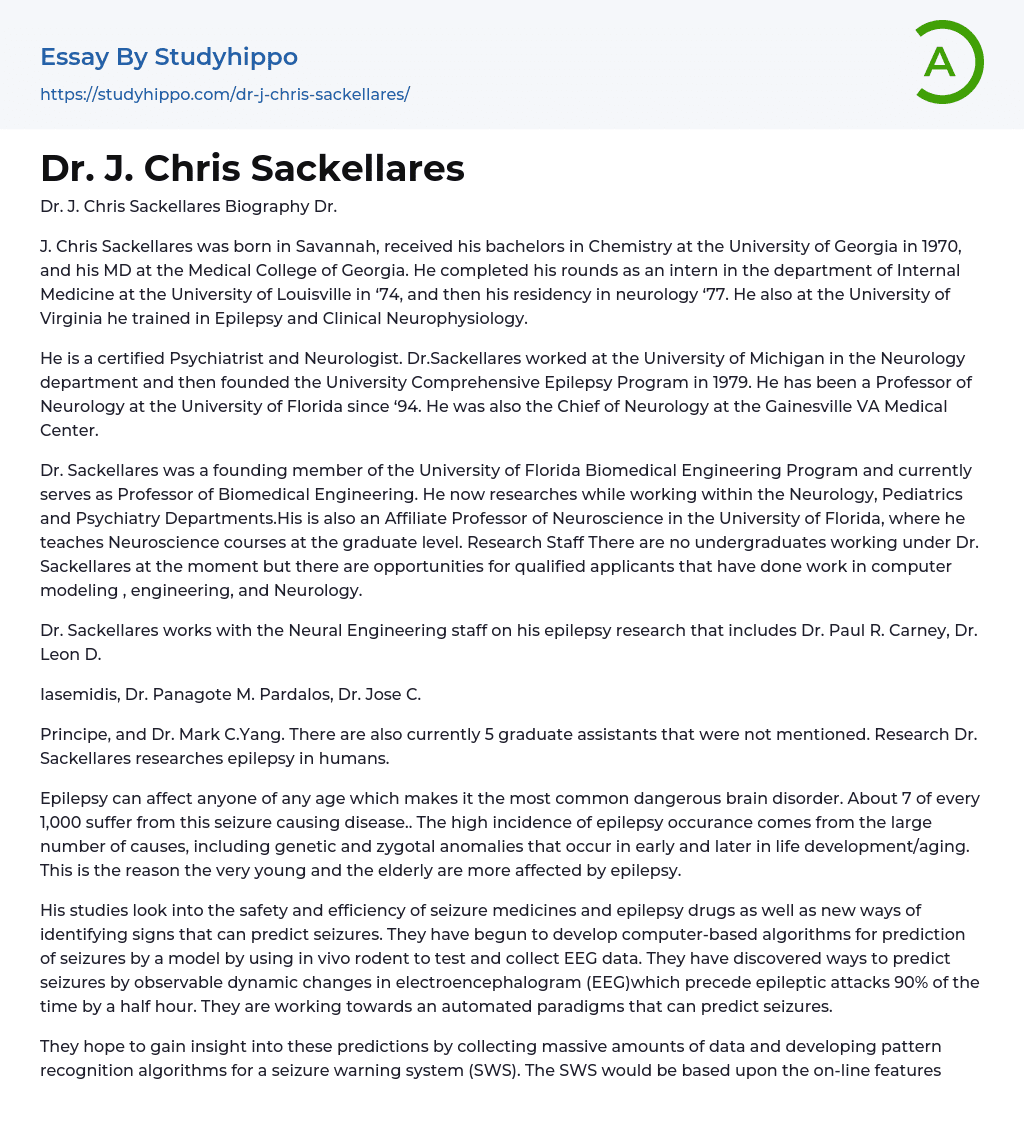Dr. J. Chris Sackellares' Biography
J. Chris Sackellares was born in Savannah, Georgia and obtained a bachelor's degree in Chemistry from the University of Georgia in 1970. He earned an MD from the Medical College of Georgia and completed his intern rounds specializing in Internal Medicine at the University of Louisville. In addition, he finished his neurology residency between 1974 and 1977 and underwent training for Epilepsy and Clinical Neurophysiology at the University of Virginia.
Dr. Sackellares is an experienced Neurologist and licensed Psychiatrist who has worked in the Neurology department at the University of Michigan. In 1979, he established the Comprehensive Epilepsy Program there. He has been a Professor of Neurology at the University of Florida since 1994 and also served as Chief of Neurology at Gainesville VA Medical Center.
Dr. Sackellares, who is a founding member of the Biomedical Engineering Program
...at the University of Florida and a Professor of Biomedical Engineering as well as an Affiliate Professor of Neuroscience there, conducts research in Neurology, Pediatrics, and Psychiatry departments while teaching graduate-level Neuroscience courses. Although he currently does not have any undergraduate Research Staff working with him, those individuals with experience in Neurology, engineering or computer modeling may be able to work alongside him.
The epilepsy research conducted by Dr. Sackellares involves collaboration with the Neural Engineering team, which includes Dr. Paul R. Carney and Dr. Leon D.
Iasemidis, Dr. Panagote M. Pardalos, Dr. Jose C.
Along with Dr. Principe and Dr. Mark C. Yang, there are currently 5 unmentioned graduate assistants. Dr. Sackellares is conducting research on epilepsy in humans.
Epilepsy, the most frequent hazardous brain disorder that can impact any age, causes seizures in around 7
out of every 1,000 individuals. Many factors can cause epilepsy, such as genetic and zygotic abnormalities in both early and late-life development/aging, which explains why it affects the young and elderly populations more.
Research is focused on investigating the safety and effectiveness of seizure medications and epilepsy drugs, alongside identifying novel approaches for detecting indicators that can anticipate seizures. Development of computer-based algorithms is underway for seizure forecasting, using in vivo rodent experimentation to gather EEG data for analysis. Notably, when dynamic changes in EEG readings are observed, seizures can be predicted with 90% accuracy up to 30 minutes ahead of time. The ultimate goal is to create an automated paradigm for predicting seizures.
Researchers are gathering significant amounts of data and developing pattern recognition algorithms to create a seizure warning system that relies on the dynamical properties of brain electrical activity. This goal could be achieved using techniques such as Electroencephalogram (EEG), complex nonlinear systems (computer models), multivariate time-series analysis, optimization techniques, neuroimaging, and neurosurgery. To complement these computer predictions, experts are designing an implantable device that uses electronic pulses to prevent seizures before they occur. Dr. Sackellares and his research group along with other laboratories like the Brain Dynamics Laboratory at the McKnight Brain Institute and the Epilepsy Monitoring Laboratory at Shands Hospital are collaborating closely in this project. The bibliography includes Holmes GL, Sackellares JC, McKiernan J, Ragland M, Dreifuss FE's study which assessed childhood pseudoseizures using EEG telemetry and video monitoring.
J Pediat 97:554-558, 1980. Two cases are reported where shoulder enlargement was the initial sign of syringomyelia. The literature on the subject is also reviewed (Sackellares JC, Swift TR). In another case study,
a patient who received penicillin experienced myoclonus and electrocerebral silence (Sackellares JC, Smith DB). This was reported in Arch Neurol 36:857-858, 1979.
Sackellares and Dreifuss published an article in Current Prescribing in 1979 about treating epilepsy in children, while another article in Epilepsia from the same year focused on patients who experienced stupor after taking valproic acid in conjunction with other antiepileptic drugs. Additionally, Sutula, Sackellares, Miller, and Dreifuss explored the use of intensive monitoring for refractory epilepsy.
The neurological publication from 1981 can be found in Neurology, with the page numbers being 31:243-247.
- Pregnancy essays
- Death essays
- Asthma essays
- Chronic Pain essays
- Diabetes essays
- Infection essays
- Infertility essays
- Pain essays
- Sexually Transmitted Disease essays
- Cholesterol essays
- Epidemic essays
- Pathogen essays
- Symptom essays
- Water supply essays
- Myocardial Infarction essays
- Chronic essays
- Hypertension essays
- Black Death essays
- Breast Cancer essays
- Down Syndrome essays
- Apoptosis essays
- Tuskegee Syphilis Experiment essays
- Type 2 Diabetes essays
- Hospital essays
- Physician essays
- Health Care Provider essays
- Universal Health Care essays
- Readmission essays
- Cloning essays
- Medical Ethics essays
- Patient essays
- Therapy essays
- drugs essays
- Cannabis essays
- Aspirin essays
- Cardiology essays
- Hemoglobin essays
- Pharmacology essays
- Surgery essays
- alternative medicine essays
- Plastic Surgery essays
- Organ Donation essays
- Vaccines essays
- Medical essays
- Dentist essays
- Psychological Trauma essays
- Physical therapy essays
- Cold essays
- Cocaine essays
- Why Marijuana Should Be Legalized essays




